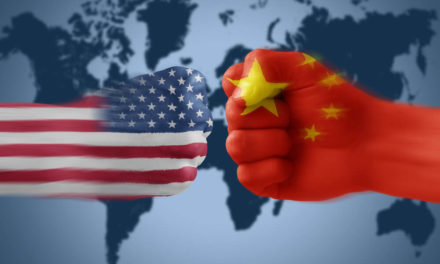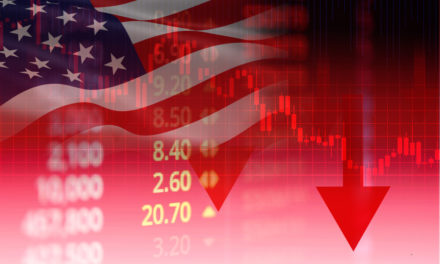Stocks dropped 3% on Wall Street, their worst loss of the year, after China countered President Donald Trump’s latest tariff threat by letting its currency weaken to the lowest level in more than 10 years and more in Monday’s Stock Market Update.
“The Great China Trade Deal evaporated before our eyes last week and investors should stop hoping it back into existence.”
The escalations in the trade war between the world’s largest economies are rattling investors already unnerved about a slowing global economy, falling U.S. corporate profits and possibly too-weak inflation.
“The Great China Trade Deal evaporated before our eyes last week and investors should stop hoping it back into existence,” Christopher Smart, head of the Barings Investments Institute, wrote in a report.
Losses were steep and worldwide as the sell-off that began Monday in Asia swept westward through Europe to the Americas. Investors in search of safety herded into U.S. government bonds, which sent yields plunging lower.
The yield on the 10-year Treasury note, which rises with expectations of stronger economic growth and inflation, fell to its lowest level since Trump’s 2016 election energized markets, down to 1.74% from 1.85% late Friday. The yield on the 2-year note sank to 1.59% from 1.71% a day earlier. Both are unusually large moves.
STOCK MARKET UPDATE
The S&P 500 fell 87 points, or 3%, to 2,844. The Dow Jones Industrial Average sank 767 points, or 2.9%, to 25,717. The Nasdaq fell 278 points, or 3.5%, to 7,726.
Of course, the U.S. economy is still growing, the unemployment rate remains close to its healthiest level in nearly half a century and U.S. stock indexes set record highs just over a week ago. But the escalating trade tensions and disappointment that the Federal Reserve has not committed to a lengthy series of interest-rate cuts have sent the S&P 500 on a losing streak set to hit its sixth day, which would be its longest since October. The S&P 500 is 5.8% below its record.
“A recession is still unlikely, but the probability of it is higher, still at less than 20%,” said Nate Thooft, head of global asset allocation at Manulife Investment Management. The biggest threat coming out of the past week, he said, is that all the uncertainty about trade will scare CEOs and shoppers away from spending. That would threaten the expected ramp up in growth that economists have been expecting to see later this year.
A weaker yuan gives Chinese manufacturers a boost by making their products cheaper on worldwide markets for buyers using dollars or other currencies. That hurts U.S. manufacturers, which have already been hit by the slowing global economy. It also adds more downward pressure on inflation, which some economists worry may be edging toward too weak. In the worst case, falling prices encourage people and companies to hold off on buying things, which starts a vicious cycle of less and less economic activity.
The U.S. has long complained about the weakness of China’s currency, and Monday’s drop brought the yuan past a level that traders saw as an important psychological benchmark, at seven per $1. Analysts were mixed, though, on whether the move was a result of China weaponizing the yuan or merely a reflection of its own slowing economy and the painful effects of tariffs.
The latest round of tariffs threatened by Trump would much more directly hit U.S. consumers buying clothes and electronics made in China. Earlier tariffs more heavily affected businesses, which have already pulled back on their investment given all the uncertainties about trade and the global economy.
Technology stocks bore the brunt of Monday’s selling, and Apple slid 5.2%. It not only depends on Chinese factories to assemble its iPhones, but China is also the only country aside from the United States that accounts for more than 10% of its sales. Chip stocks were also among the hardest hit in the S&P 500, and Nvidia sank 6.4%.
Monday’s plunge in bond yields dragged on banks by making lending less profitable. Bank of America fell 4.4%, Citigroup lost 3.5% and JPMorgan Chase dropped 2.9%.
Companies are in the final stretch of the latest round of quarterly earnings reports, and results haven’t been as bad as initially feared, though still down from year-ago levels. Profit for companies in the S&P 500 is now expected to contract by roughly 1%. That’s better than the nearly 3% drop earlier expected. More than three quarters of the S&P 500 have reported financial results.
Meat producer Tyson Foods jumped 5% for the biggest gain in the S&P 500 after it reported profits that were better than Wall Street expected. It was one of only 15 stocks in the S&P 500 able to eke out a gain.
In Asia, where tensions between Seoul and Tokyo are worsening in a trade dispute entirely separate from Washington’s and Beijing’s, Japan’s Nikkei 225 index fell 1.7%, and South Korea’s Kospi lost 2.6%. The Hang Seng in Hong Kong dropped 2.9%.
In Europe, France’s CAC 40 fell 2.2%, and the German DAX lost 1.8%. The FTSE 100 in London dropped 2.5%.
© The Associated Press. All rights reserved.




